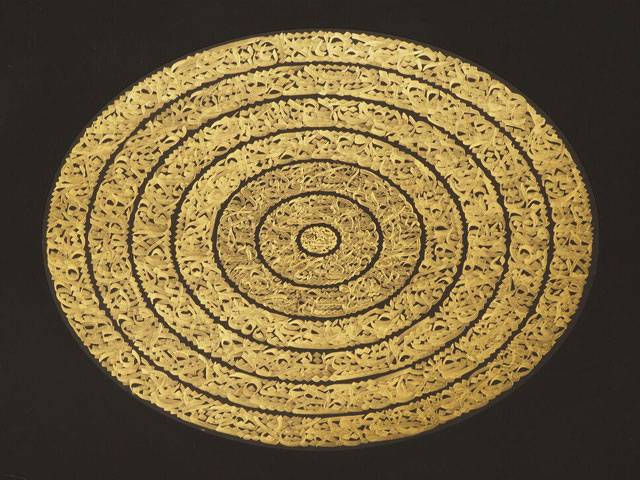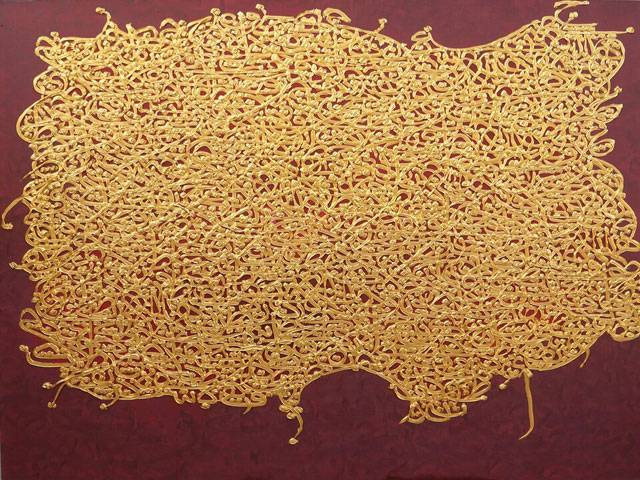LAHORE-Hand writing is a skill which many struggle to master especially when they are small. It is personal yet universal, functional yet ornamental and often taken for granted since the Digital Age. However, besides being all these things hand writing has also been an ancient art form by way of which humans have been communicating regardless of centuries.With time ever growing set of rules has made this countenance denser. The word calligraphy with its Greek origin generally means beautiful hand writing. Having a long inventive inheritance, gradually becoming an art form, calligraphy now is an extensively practiced phenomenonworldwide.
As for the western civilization, man was the measure of beauty, ugliness, myth, reality, virtue or vice. On the contrary, the Islamic world seeking its ideals from the holy Quran, relied upon a system of carefully delineated handwritten scripts often served as social and political tool. Prohibition of representing figure in Islamic ideologyalso paved the way towards the fineness of this expression. Later in mid-15th century, invention of the printing press also increased its exclusiveness.
In the machine-made world, when the sight of a hand written word becomes rare, a letter being born on the surface of a paper is a handcrafted revelation with intensely satisfaction. Hand writing and calligraphy both have handmade element in their existence, but there are circumstances that turn the former into the latter.To write is to be human, to write beautifully could be someone’s capacity but to write with rules is an act of patience and prudence. When it enters into the realm of creativity handwriting wears a formal attire by swaying along the specific movement patterns and spatial relationships between the beginning and the ending of each letter, from careful crossing of the t’s to the delightful dotting of the I’s, from the stretching of the U’s to the circling of the O’s.
Traditional calligraphy involves spiritual subject matter hence the text has to be decipherable. If the calligrapher makes the shift in the nature of content of his work what sort of transition would happen in the aesthetical and philosophical value of his work? Serving a purpose of artistic expression, more than a tool to communicate a specific message like in the past, contemporary practice of calligraphy has no such boundary where the text needs to be readable. Hence recently, the artists are exploiting not only the form but the subject matter too.
Muneeb Ali, a young emerging visual artist from Lahore, is a graduate from College of Art and Design Punjab University and has been expressing himself through calligraphy from quite some time. Besides exploring the qualities of line, color, composition and structural territories of the letters, he pays equal attention to the content of the written word too but here he has a different story to tell. One of the ground reasons of opting out calligraphy as his medium of expression is his demure nature so he liberates his emotions on to the canvas through striking visual dialogues. With interlocking layers of thick paint, hiscolor palette takes strong participation in every conversation happening.
Imparting feelings and expression only through a word or a letter is a bit of a challenge. With an unusual aesthetic code, his work becomes an exquisite blend of calligraphy and graffiti, often called calligraffiti, when he opposes the idea of working with a single font. Carefully mixing a couple of fontshe prepares an inviting concoction of handstyles. Thuluth, Diwani and Shikastaare among his favorites to play with.The title of his latest solo Haroof confirms his notion of playing with the essence to yield amusing results. But this playfulness is made possible after strict regime of constant practice sessions with a single font for sometimes a whole year.
Talking about the process, he kicks off with asketching session, deciding upon the color, start with a unit and then the rest goes along. The making of the tools and surfaces enables the artist to develop a strong bond even before the work is started. After much experimentation with the basic tool, Muneeb devised his own way of working. Since then qalam has not made a comeback in his work.
When Muneeb says all begins with the dot he points out towards the discipline thisartfollows. Unlike some human dispositions this is an activity that demands patience and poise like an act of performance akin to playing an instrument, comprising warily delineated steps learned and practiced over a stretch of time and refined over and over again. It is not solely about ornamentation or decorative lettering but a visual music that our eyes listen to. Marc Drogin while talking about Medieval Calligraphy defines the act of writing as to placing one’s soul at the tip of the pen so the world can see it.
No one is sure how long the pen would continue to be set on paper in everyday use; however, the whimsical world of today’s calligraphic art seems unstoppable. Besides continuing the legacy of an ancient art form, today’s calligraphy in local scene seems to be celebrating independent. Through exceptional approaches towards from and content, contemporary practitioners are giving a spin to this traditional practice. From single pass of the pen to building up layers of letters in ink or pigment, contemporary calligraphy is soaking up all the attributes which once have segregated various disciplines of writing.







